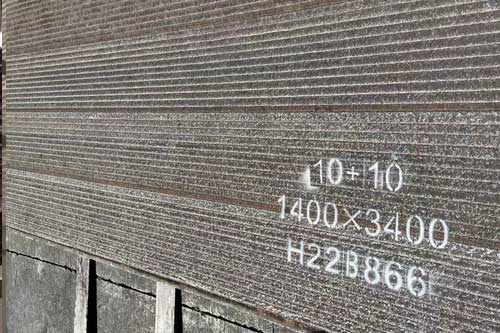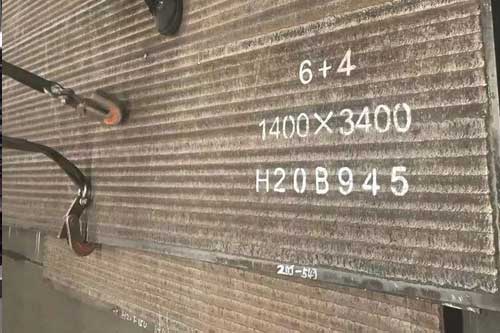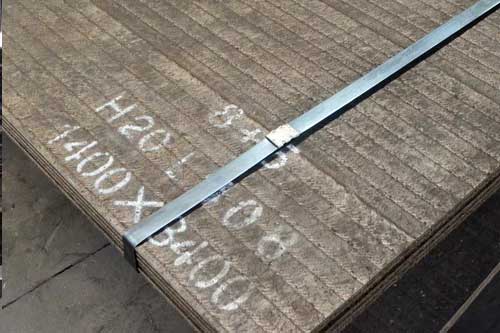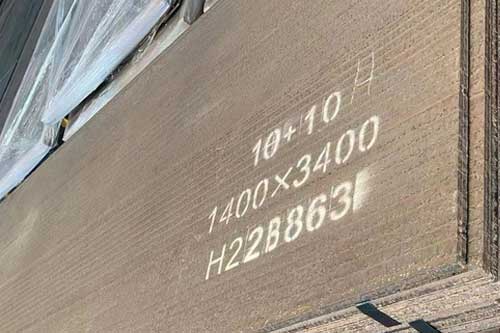Product Images
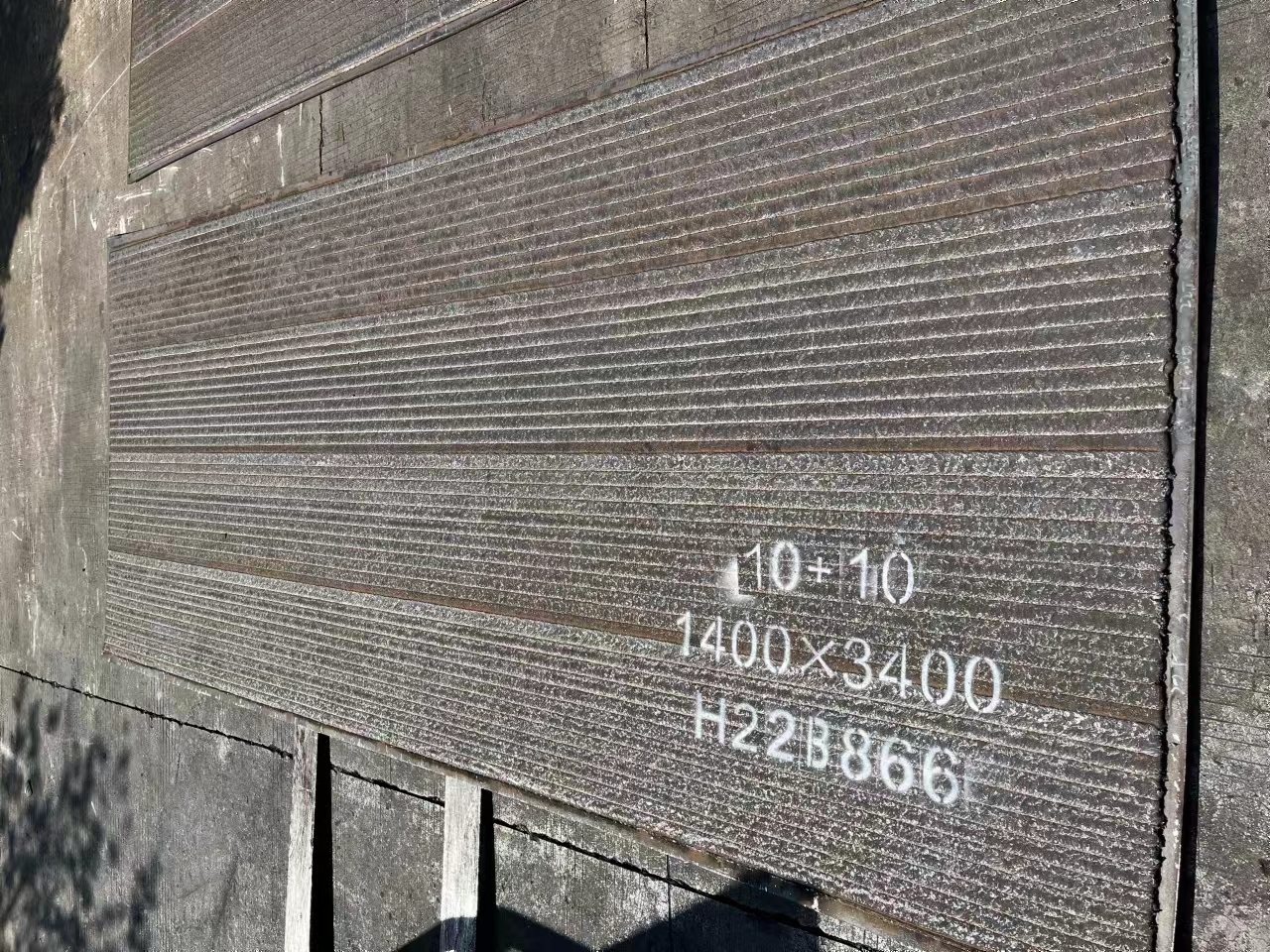
Product Images
Bimetal surfacing wear plate Chemical Composition
| Bimetal surfacing wear plate |
| Model |
Hardness |
Chemical Composition (%) |
Operating Temperature |
| (HRC) |
C |
Cr |
Mn |
Si |
Mo+Nb |
Ni+V+W |
Fe |
| SY-D |
58-65 |
4.0-7.0 |
25.0-40.0 |
/ |
/ |
/ |
/ |
Bal. |
<900℃ |
| Characteristics |
Heat resistant wear plate, heat resistance maximum up to 900℃ |
| Composition: |
The wear-resistant composite steel plate is a layer or multiple layers of wear-resistant alloy containing a large number of chromium carbide hard particles deposited on the medium and low carbon steel substrate, and some special elements are added to form carbides with special effects. |
| microstructure: |
The volume fraction of Cr 7C3 carbide in the metallographic structure of the wear-resistant layer reaches more than 50%. |
| Hardness: |
According to the thickness of the wear-resistant layer and the application, the surface hardness of the wear-resistant alloy ranges from HRC56-65, and the micro-hardness of chromium carbide is up to HV1800. |
| Abrasion resistance: |
Laboratory results show that the wear resistance of high-chromium surfacing wear-resistant composite steel is 20 times that of low-carbon steel and 8 times that of heat-treated wear-resistant steel. ASTM-G65A dry sand wear test surface wear and 75% deep wear test The data shows that it has high wear resistance. |
| Flatness: |
The flatness is controlled at soil 3mn/m. |
| Thickness error: |
The thickness of the wear-resistant layer is uniform, and the thickness tolerance is 0-0. 5mm. |
| Common thickness specifications of wear plates(base plate)+(chrome overlay): |
3+3,4+4,5+5,6+4,6+5,6+6,8+5,8+6,8+8,10+5,10+6,10+7,10+8,10+10,12+5,12+6,12+7,12+8,12+10,12+11,12+12,14+6,14+8,14+10,16+6,16+8,16+10,18+6,18+8,18+10,20+6,20+8,20+10,30+10,40+10 |
| Regular width length |
1400*3400mm 1400*3000mm 1500*3000mm 1400*3500mm 2000*3000mm 2100*3500mm Other on request |
| Conventional substrate material |
Q235, Q345 and so on. |
| Conventional thickness |
Overlayer thickness: 3-50mm |
Product Images
Bimetal surfacing wear plate is the application of powder metallurgy composite technology and hard surfacing welding technology, through carbon arc and special equipment for surfacing welding, high-boron alloy surfacing on ordinary low carbon steel or low alloy steel plate with good plasticity It is made of cast iron materials, and can be made of different thickness wear-resistant layers according to customer requirements and different working conditions. Because the wear-resistant layer is arc welding stress dispersion, the surface produces micro cracks, which will not spread to the substrate and will not affect the resistance. Grinding performance.
Processing and use:
- Welding:The DS substrate is a steel plate with good weldability. When DS is connected to the steel, the back substrate is welded together, and then the front wear-resistant layer is welded with the corresponding DS brand electrode. DS can also be applied to other steel structures.
- Bolt fixing:The bolts can be welded to the DS substrate by flash welding or melt welding, and then connected to the workpiece, or holes can be made on the DS and connected to the workpiece by bolts.
- Plug welding:Open a hole on the DS and connect it to the work by plug welding, and then use the corresponding DS brand electrode to weld the front wear-resistant layer.
- Cutting:Because the surface of DS is welded with high-boron alloy cast iron, flame cutting is not possible. Only plasma cutting machine, laser cutting and electric discharge machining can be used. According to experience, in order to prevent the wear-resistant layer from falling off the substrate during cutting, it is recommended to cut from the substrate surface.
- Bend:The DS can be bent into an arc according to needs, but it is recommended that the bending should be along the direction of the welding bead, and the bending radius should not be too small
Application range of Bimetal surfacing wear plate
Application scope of port conveying equipment: Grabs, hoppers, chutes and other parts in bulk cargo handling systems such as iron ore and coal are subject to severe abrasion. Welding and wear-resistant composite steel plates are used in the easy-to-wear parts to extend these wear parts. It is very important to reduce the downtime of loading and unloading machinery for maintenance.
Applications in the mining industry: truck cargo tank lining, hopper lining, conveying chute lining, crusher parts, cover plates, wear bars and wear plates, electric shovel, shovel, slagging machine, loading Machine bucket, bulldozer bucket, dragline.
Application scope in the power plant industry: in fan blades, burner pipelines, lining of conveying troughs and hoppers, crusher parts, coal mill parts, ash outlet pipes, air handling systems and conveyors, chutes, pipe trough systems, coal feeding Trough, feed pipe trough, grab hopper trough, coal feed trough pipe, separator cone. Coal feed hopper, raw coal feed pipe trough, fuel conveying pipe, exhaust fan blade, coal mill cylinder liner, coal mill roller head liner, coal drop tube wear-resistant elbow, coal mill inner wall liner, Baffle plate, rotating air ring, coal falling trough, wear-resistant short pipe, burner combustion chamber, burner elbow,
The scope of application in the steel plant is: on-line surfacing repair of broken rolls in sintering plants, roll surfacing welding wires, silo liners, sliding slopes, screens, blast boiler bell covers, feed cars, blast boiler reinforced steel plates, and sintering Feeding barrels, pipes, distribution plates.
Cement industry applications: powder separator blades, impact discs, pipes, pump casings, mill linings, crusher parts, slag troughs, various chassis, vibrating screens, etc.
Applications in the coal industry: feed troughs, middle troughs, hoppers, crusher parts and liners, coal conveying pipes, elbows, scraper conveyor bottom plates, pump bodies, etc.



